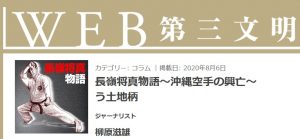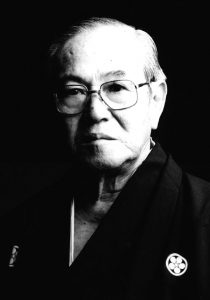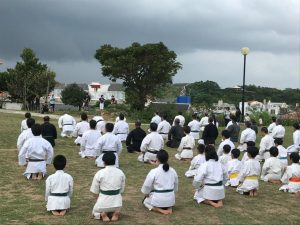In the past, we have introduced Yanagihara Shigeo’s serial publication “The present of Okinawa traditional karate”.
Mr. Yanagihara has started a new series related to karate titled "Nagamine Shōshin Monogatari - The ups and downs of Okinawa Karate". Scheduled to be 12 episodes long, already 3 articles have been published. Although in Japanese, using an online translating software might be a good way to read through this interesting series.
WEB Daisan Bunmei: https://www.d3b.jp/npvolumn/10642
Note: The opinions expressed in the series and on this website are only those of the authors, not the opinions of the Information Center.
The Okinawa Prefecture has begun preparations for the “1st Okinawa Karate Youth World Tournament”. Details will be announced in the future, but here is the basic information that we are aware of at this moment.
Name: The 1st Okinawa Karate Youth World Tournament (tentative)
Organizers: Tournament’s executive committee, Okinawa Prefecture, ODKS
Support: National related organizations, prefecture municipalities, etc. (planned)
Dates: August 11~18, 2021 (8 days including preliminary days)
Venues: Okinawa Prefectural Budōkan, Okinawa Karate Kaikan
* In addition to changing the content of the event, be aware that it may be suspended or postponed in light of the status of new coronavirus pandemic.
In May 1922, Funakoshi Gichin introduced Ryūkyū karate at the "1st Athletic Exhibition" sponsored by the Ministry of Education. After that, a public demonstration was also held at the Jūdō headquarters, the Kōdōkan. At that time, Gima Shinkin (1896-1989) also known as Gima Makoto served as an assistant to Funakoshi sensei.
Mr. Gima graduated from Okinawa Prefectural Normal School where he learned karate from masters Itosu Ankō and Yabu Kentsū. Later, he went on to Tōkyō College of Commerce (now Hitotsubashi University). Following the demonstrations, he strived to popularize karate. His teachings have been inherited as Gima-ha Shōtōkan-ryū Karatedō (Website in Japanese).
Below, we introduce an article written by Gima sensei titled “Perseverance makes one stronger”.
Furthermore below, we also introduce a translation of a message depicting Gima sensei by Higaonna Morio sensei, intangible cultural asset holder designated by the Okinawa Prefecture. The message was written for the celebration of the 23rd anniversary of the death of Gima sensei and the celebration of his successor Higuchi Shihan’s seventieth birthday on September 23, 2011.
“Perseverance makes one stronger”
JKF Adviser
81 years old
Gima Shinkin
(Forewords) I was born in Shuri Kinjō-chō, Okinawa. The place resembled a valley bottom, and anywhere one would go, there were steep zigzagging stone paved slopes. When I was young, I climbed them up and down with bare feet, so my legs became strong. In addition, because I was from an extremely poor family, we lived a frugal life. When it was time to move to a higher education, we couldn’t afford school expenses so I had to work part-time among others. Furthermore, as I had a weak body as I was born from a 57 years old father and a 46 years old mother, I devoted myself to karate and seiza sitting from the age of fifteen in the sake of health first. I also read Smiles' Saikoku Risshi Den (1) and self-improvement books. Upon such reading, I was highly inspired as it seems that great men also had gone through hardships.
Next, at the request of the Karate Shimbun, I would like to say a few words about karate from my poor experience for my promising juniors.
“A correct fist starts with a correct heart”. Originally, the purpose of karate is to train the mind and body. In other words, through karatedō one tries to achieve personality completion. In this sense, in the old days in Okinawa, karate masters were called Bushi. They were men of character, namely, true gentlemen.
Well, by improving his/her skills, one can reach a certain level, but in the mental aspect, there is no ending point in life. By training hard constantly, it resembles Zen practice hence the saying “Ken Zen Icchi” or the fist and Zen are one.
In addition, although one should train rigorously (2), the meaning of the Japanese kanji ‘Keiko’ is to observe ancient times; ‘Kei’ means to observe while ‘Ko’ means ancient times. Therefore, following the precept “Onko Chishin” – to develop new ideas based on study of the past, one should learn (to learn is to copy), and practice by repetition the kata that were devised with great pain and time by past grand masters. Based on this, one should develop naturally. And then, rather than being a three-day priest, one should make efforts over efforts, and continue for a lifetime as the proverb “Perseverance makes one stronger” says.
Old soldiers fade away. I write these words with the hope that young people who have a promising future will spring over seniors and go forward eagerly. Finally, my dear gentlemen, a poor poem of mine.
Let man be the model (mirror) of many people
Young people, polish the spirit of karate
And I will lay down my pen.
(The author is an advisor to the Tōkyō Karatedō Federation and chairman of the Shibuya district Karatedō Federation)
Published in the Karate Shinbun Issue 98
Tenbōsha column
Publisher: Karate Shinbun Corporation
Date: August 20, 1977
Notes:
(1) Refers to Samuel Smiles’ book “Self-Help” published in 1859.
(2) In Japanese, “Yoku keiko seyo”
********
Gima Shinkin sensei
By IOGKF Higaonna Morio sensei
From a letter from Higuchi Ikuo Shihan, I was made aware of the 23rd memorial service for Gima sensei, and I remembered the times of the Yoyogi Shūrenkai Dōjō 40 years ago. Realizing that 23 years have gone since the passing of Gima sensei, I felt that time passes fast.
Gima sensei was a martial expert as well as an educator. It can be said that he was a Bushi who had mastered the way of the pen and the sword. I believe that Gima sensei’s achievements in promoting karate in mainland Japan are great.
On the invitation of Kanō Jingorō sensei, he performed a karate kata demonstration along with Funakoshi Gichin sensei at the Judō headquarters Kōdōkan. This was a great opportunity (effort) for the popularization and development of karate.
I think I met Gima sensei for the first time in the 1960s through the Yoyogi Shūrenkai at the banquet hall on the second floor of the Nagasaki Hanten restaurant. After that, at the request of Aragaki sensei (3), I think he taught three times a week (Tue, Thu, Sat) at the Yoyogi Shūrenkai Dōjō.
I believe that Higuchi Ikuo Shihan instructed as an assistant on behalf of Gima sensei. Gima sensei retired from the education world, worked for Kashima Construction Co., Ltd. and instructed at the karate club of the said construction company. I have seen demonstrations of Gima sensei with Higuchi Shihan at the All Japan Karatedō Championships at the Nippon Budōkan in Tōkyō. The throwing techniques were so splendid that I still have them in mind. It can be said that ordinarily, Gima sensei was a calm and quiet person.
I have been impressed by Gima sensei knowledge on the history of Okinawan karate, especially about people and their birthdates etc. Once, Gima sensei taught me a kata of bō (stick) that he had learned it from Gigō, the 3rd son of Funakoshi Gichin sensei. I was especially impressed and can’t forget the extreme power of his way of striking with the bō.
The dōjō-kun (4) were also teachings from Gima sensei. Regardless of style, all those who trained at the Yoyogi Shūrenkai Dōjō were touched by his virtues and so he is alive in everyone's heart. I would like to devote myself to the gratitude of the teacher as a treasure of my life. I would like to persevere engraving in my heart the kindness of Gima sensei as a treasure of life.
The Gima-ha Shōtōkan style has been passed on to the fine martial artist that is Higuchi Ikuo sensei to whom I extend my deepest homage.
To Gima sensei, I extend my heartfelt gratitude.
Joining hands in prayer
Notes:
(3) The owner or the Yoyogi Shūrenkai Dōjō.
(4) The precepts of a dōjō, often exposed on a board inside a dōjō.
We are proud that when speaking of karate, Okinawa comes to mind, and when speaking of Okinawa, karate comes to mind! Yet today, karate, which has been acknowledged universally, sees its shape changing. It is springing up like bamboo shoots after the rain as sport karate and karate dōjō are scattering all over the world. Fictions are also publicized in newspapers and magazines as well as in movies and on television.
For example, four years ago, the 1st World Karatedō Championship was held at the Budōkan in Tōkyō, and athletes from 38 countries around the world gathered and lined up each holding their national flags during the marching band performance. This soul-stirring scene was enough to make one imagine it as a part of the World Olympic Games. Last year, the same type of championship was held in New York, USA and a tournament is scheduled to be held in Paris France this year. Now we the executives of the federation are wondering if the karate of Okinawa, which is promoting Okinawa as its birthplace, should stay the same as it is now. We are thus repeatedly researching on this matter during head of styles’ sessions and board of directors meetings.
Nevertheless, since Bu – martial art is written with the two characters meaning “to stop (止) arms (弋)”, karate has been passed on with the precepts of being an art of self-defense, a mean to temper the body and a way to be useful for others and the society. Therefore, thoroughly following the words “Seeking the old to find the new” (1) found in the motto “The secret resides in training the heart and mind” (2), we must strive to deeply explore the true essence of karate and preserve the legacy of our ancestors.
I believe that simple matters like who is strong in an actual fight, who has the most power, and who is good in demonstrating are next issues. In that sense, today's demonstration will see elementary school first grade students up to seniors aged 70 years old performing with all their might. Among them, some may be still beginners and their performances may make you smile, but please understand our intention and enjoy the demonstration until the end.
April 21, 1974
The 7th Karatedō Kobujutsu Demonstration
Sponsored by the All Okinawa Karatedō Federation
YAGI Meitoku, Chairman of the All Okinawa Karatedō Federation
Extracts from the Chairman’s congratulatory address
Notes:
(1) “Furuki wo tazune Atarashiki wo shiru”, also known as “Onko Chishin”
(2) Gōjū-ryū master Yagi Meitoku sensei’s favored quote “Ōnmyō zai renshin”
A long time participant to the Dynasty Festivals, the Shōrin-ryū Shūbukan (Location: Shuri Toribori-chō. Kanchō Uema Takeshi sensei) has organized a dedicatory demonstration on November 3 in the Sakiyama Park immediately after Shuri Castle’s fire (above photo). This was done in response to the children's strong wishes of "rebuilding Shuri Castle through karate and encouraging the Okinawan people". The event was held in collaboration with a few dōjō from the Shuri district.
At the same time, the Shūbukan and the Sakiyama district Youth Association have been actively engaged in karate and flagpoles demonstrations in the surrounding area.
Shuri Castle and karate are part of the Okinawan identity. Through this new karate demonstration, we wish to encourage the strong will of the children toward the reconstruction, and to pass on the feelings that will lead toward a bright future.
On Sunday, July 12 from AM 11:00~12:00, the first demonstration will held with some dōjō and karateka who agree to the purposes herby mentioned. It will be held in front of the castle’s information center (Suimuikan).
After this day onwards, demonstrations will be conduct on the second Sunday of each month. Participation in the performance is free and all are welcome.
The details are as follows.
Dates: Second Sunday of every month (In case of rain, the demonstration will be conducted on the third Sunday)
Time period: Until the castle’s reconstruction
Venue: Shuri Castle Park
Participating organizations: Karate individuals, karate dōjō, Shuri district children's association, 3-5 dōjōs per event, approximately 2-~50 people
Time: From 10:30 am to 12:30 am
Schedule:
- From 10:30 to 11:00: Preparations
- From 11:00 to 12:00: Karate demonstration and children's association eisā drum performance, etc.
- 12:00 to 12:30: Withdrawal
Sponsor: Supporting karate dōjō party for Shuri Castle Reconstruction
Responsible body: Shōrin-ryū Shūbukan
Contact: Shōrin-ryū Shūbukan’s PR person – Hasegawa 080-6660-7861 (English-speaker)



